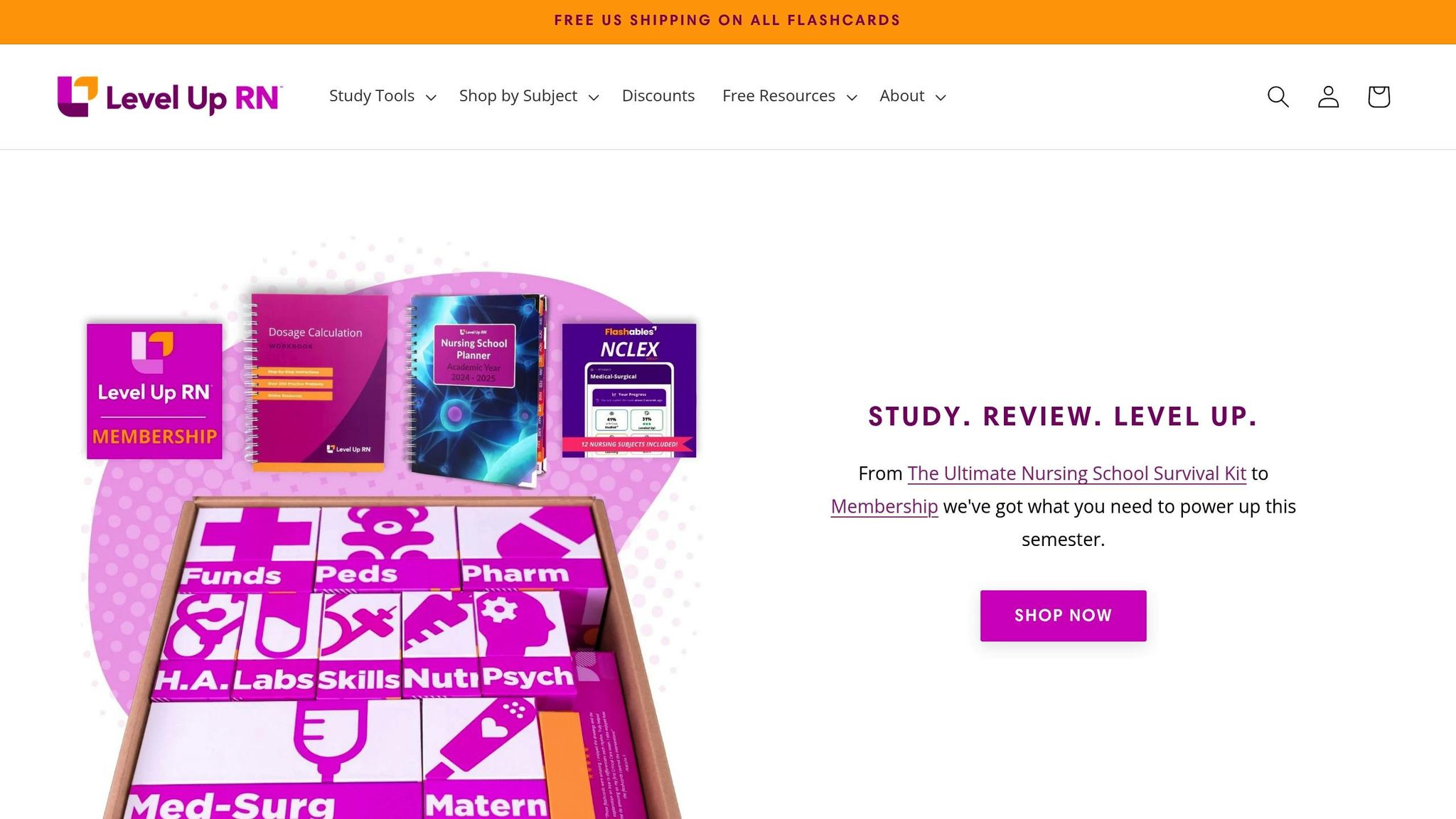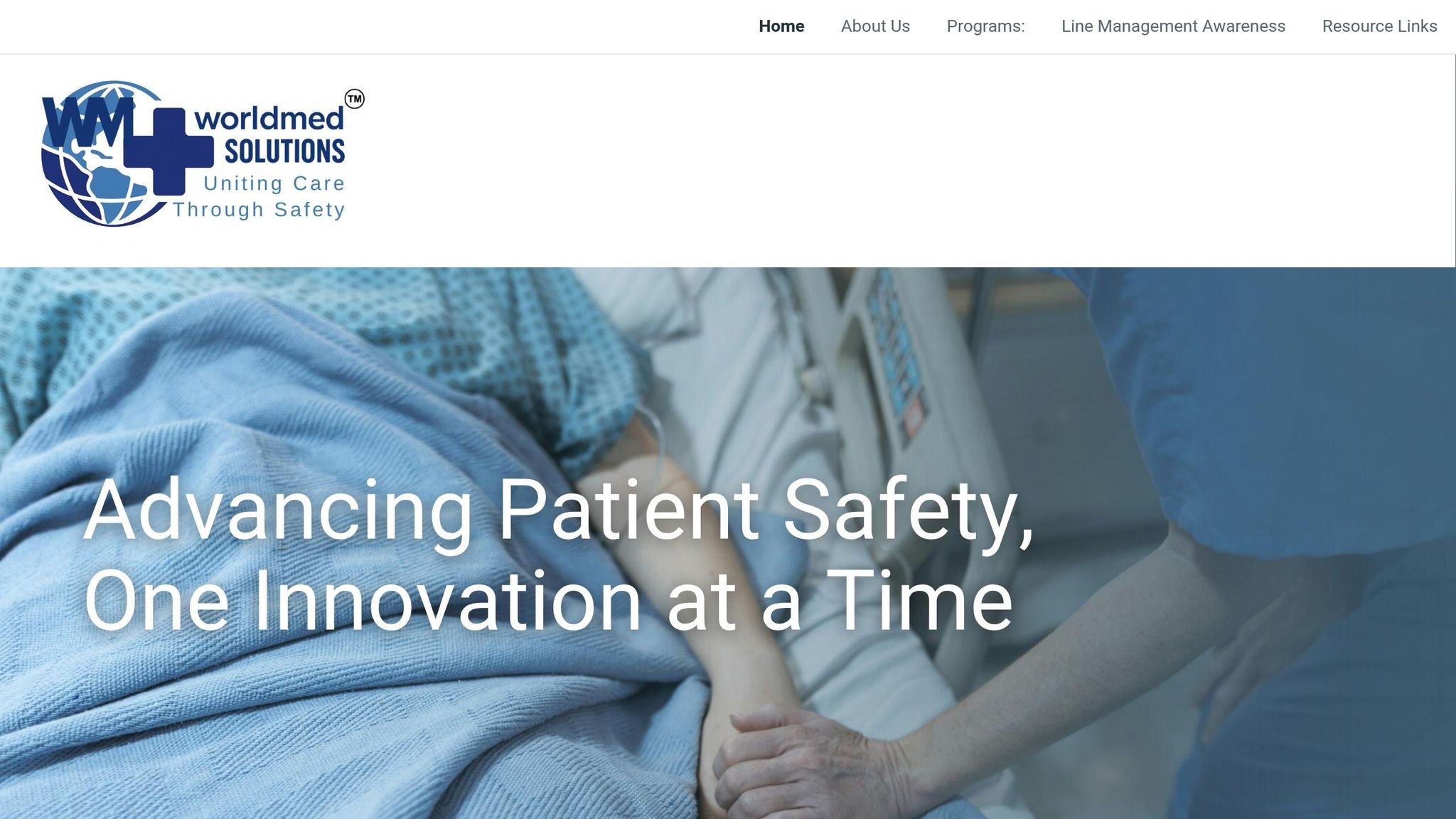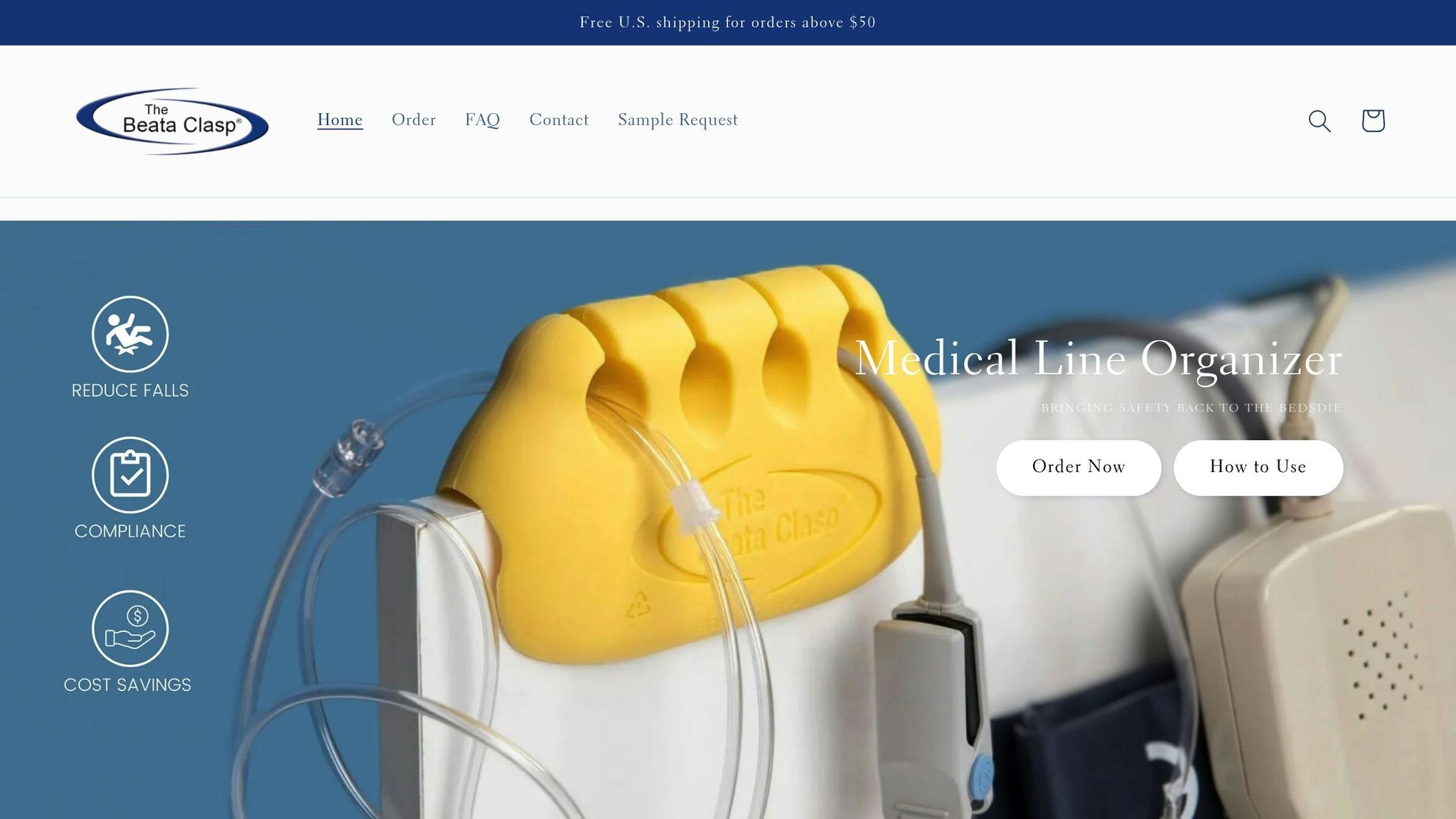IV line management is critical for patient safety, yet errors remain common and costly. WorldMed Solutions addresses this with a specialized program that reduces risks, improves workflows, and enhances training. Here's what you need to know:
- The Problem: 50% of IV lines fail before discontinuation, and complications occur in up to 42% of catheter insertions. Errors in IV administration are five times more likely to cause harm than other methods.
- The Solution: WorldMed Solutions' program focuses on staff training, workflow integration, and evidence-based methods to reduce errors and improve outcomes.
- Key Tools: The Beata Clasp organizer prevents line tangles, reduces infection risks, and streamlines workflows.
- Results: Facilities using structured IV management programs report fewer complications, lower costs, and better patient outcomes.
With a focus on clear protocols and advanced tools, this program helps healthcare teams minimize risks and improve care.
IV Complications - Pharmacology Basics | @LevelUpRN

WorldMed Solutions' Line Management Awareness Program Components

WorldMed Solutions has developed a program that combines training, workflow integration, and research-backed practices to improve IV line safety. By focusing on these key areas, the program aims to create a strong foundation for safer IV management. Here's a closer look at how the program works.
Staff Training Modules
The training modules center on three main areas: organizing IV lines properly, preventing risks, and following protocols closely. These modules include real-world scenarios to prepare staff for emergencies involving IV lines. With healthcare providers spending an average of 15.6 hours per week on administrative tasks, this program prioritizes efficient training to free up more time for patient care.
Training includes annual competency assessments to ensure skills remain sharp. The curriculum covers essential topics like choosing the right site for IV placement, rotation policies, and using automated checklists to assess risks before starting an infusion. Hands-on practice sessions help staff spot and address common issues like phlebitis, infiltration, and bloodstream infections. A major focus is placed on using ultrasound guidance for catheter placement. Studies show that nearly 58% of successful IV placements involve ultrasound, and trained nurses using this technique can reduce the need for central venous catheters by up to 80%.
Clinical Workflow Integration
This program seamlessly fits into existing healthcare operations, helping streamline processes. Research shows that organizations mapping workflows before automation can cut implementation time by 25%, while integrated systems reduce workflow errors by 30%. The program uses automated closed-loop systems to notify physicians of critical lab values and incorporates tools like barcode scanners and RFID tags to improve patient identification and medication administration accuracy. These measures standardize care and address systemic workflow challenges.
Additionally, routine administrative tasks, such as patient registration and appointment scheduling, are automated, allowing staff to focus more on patient care. Real-time analytics track performance metrics, enabling proactive management. Hospitals that automate administrative tasks have reported a 30% reduction in workload.
Evidence-Based Methods for Success
The program takes an evidence-driven approach, addressing the fact that IV failure rates can reach 53%, with infiltration rates exceeding 16% in some cases. To combat these issues, it incorporates advanced technologies like smart infusion pumps equipped with pressure sensors and alarms.
Specialized Vascular Access Teams (VATs) play a critical role, using advanced techniques to respond quickly to complications. Patients are also educated through detailed materials and pre-treatment briefings to help them identify early warning signs of issues.
One powerful example comes from a neonatal intensive care unit study. Initially, the IV infiltration rate was five per 1,000 line days. After implementing evidence-based guidelines - including better surveillance, prevention strategies, and compliance checklists - the rate rose to nine per 1,000 line days. However, severe Stage 4 infiltrates significantly decreased, reflecting improved outcomes.
The program also includes incident reporting software, enabling real-time tracking and analytics for continuous improvement. Automated claims processing further enhances efficiency, increasing approval rates by 20% and potentially saving the healthcare system up to $16.3 billion annually.
IV Line Organization Best Practices
This section builds on earlier discussions about training and workflow integration by offering practical guidelines for organizing IV lines. Effective IV line organization hinges on clear labeling, infection prevention measures, and regular compliance monitoring. Together, these practices ensure safe IV therapy and enhance the strategies already covered.
IV Line Organization and Labeling Guidelines
Proper labeling is crucial to avoid medication errors and mix-ups, especially since 80% of hospitalized patients receive IV treatments. In the U.S., medication errors can occur as often as 1 in 5 doses, while UK hospitals have reported an intravenous administration error rate of 53%. Clearly, standardization is key.
Labels should be placed on each distal port and the tubing, positioned near the insertion point on the patient side. They must include essential details like the drug name, concentration, dose, preparation time, change schedule, and initials. Importantly, labels should not obstruct medication administration.
To visually differentiate lines, labels can vary in color or size, but relying solely on color is discouraged since color coding is often reserved for drug classes rather than individual medications. Adding medication flags can provide an extra layer of clarity.
Standardizing labeling practices across facilities requires a collaborative approach. A cross-functional team should review current labeling methods, design labels with only the necessary information, and determine the best label size for consistency. Research shows that 60% of infusions involve at least one error, with nearly two-thirds linked to improper labeling protocols.
Change reminder labels are another useful tool. They help staff track tubing replacement schedules and maintain sterility. Additionally, flushing solutions should be at least twice the internal volume of the catheter (a minimum of 5 ml) for safe IV line management.
Infection Prevention Methods
Central line–associated bloodstream infections (CLABSIs) pose a serious risk to patients. Common pathogens include coagulase-negative staphylococci, Staphylococcus aureus, enterococci, and Candida species. These infections not only increase hospital costs but also prolong patient stays, making prevention essential.
The foundation of infection prevention lies in hand hygiene and aseptic technique. Healthcare workers must clean their hands before and after touching catheter insertion sites or performing any catheter-related procedures, such as insertion, replacement, or dressing changes. Aseptic technique must be maintained at all times.
Proper skin preparation is another critical step. Before inserting central venous or peripheral arterial catheters, the skin should be cleaned with a solution containing more than 0.5% chlorhexidine with alcohol. During dressing changes, this protocol should be repeated. For daily care, a 2% chlorhexidine wash can help reduce bloodstream infection risks. Subclavian insertion sites are often preferred over jugular or femoral sites in adults to further lower infection risks.
For dressing management, sterile gauze or transparent, semipermeable dressings should be used to cover catheter sites. Transparent dressings should be replaced every 7 days (or sooner if compromised), while gauze dressings should be changed every 2 days.
Before accessing any catheter hub, needleless connector, or injection port, the access port should be disinfected using mechanical friction with an alcoholic chlorhexidine preparation or 70% alcohol for at least 5 seconds. Daily catheter assessments are also necessary, and removing nonessential catheters promptly reduces infection risk. Using sutureless securement devices can help maintain proper catheter positioning and further minimize infection chances.
Regular Audits and Compliance Checks
Routine audits are essential for ensuring adherence to IV line safety protocols and identifying areas for improvement. These audits can uncover errors, monitor clinical operations, and provide valuable data.
An effective audit plan should include details like the audit date, auditor name, timing, criteria, and evaluation methods. Audits should focus on compliance with evidence-based practices for inserting, maintaining, and removing peripheral intravenous catheters. Combining direct nursing observations with clinical record reviews provides a comprehensive compliance assessment.
Feedback is key to turning audit results into meaningful improvements. Sharing findings with stakeholders and nursing teams fosters a culture of continuous improvement. Detailed documentation of audit outcomes, paired with clear action plans and follow-up audits, ensures corrective measures are properly implemented.
Tools like the Beata Clasp IV line organizer can enhance these practices. With antimicrobial properties and high-alert color coding, the Beata Clasp helps keep IV lines organized and off the floor, reducing contamination risks. Incorporating such tools into daily routines complements infection prevention efforts and supports better audit outcomes. These strategies ensure safer, more efficient IV line management.
sbb-itb-f779e18
Tools and Products for Better IV Line Safety
While proper training and protocols are vital for safe IV therapy, having the right tools can make a noticeable difference in maintaining safety and efficiency. Specialized equipment ensures healthcare teams can uphold consistent standards, even during hectic shifts. One such tool, designed to enhance safety and organization, is the focus of this section.
Beata Clasp IV Line Organizer Features

The Beata Clasp is a practical organizer designed to keep IV lines in order. Made from recyclable soft foam, it attaches directly to hospital bedrails, featuring circular grooves that securely hold medical tubing, lines, and drains. Its antimicrobial and latex-free material adds an extra layer of safety, while the bright yellow color ensures high visibility, making it easy for healthcare workers to identify and track lines quickly. The Beata Clasp is compatible with thicker Hillrom® bed rails and Air-Shields Resuscitaire® Radiant Warmers, offering one-handed operation for convenience. Plus, its recyclable design supports eco-friendly practices.
The cost is $19.95 per unit, with bulk options available for larger facilities - such as 25 units for $467.50 or a 10-unit evaluation pack for $163.00 - making it a cost-effective choice for widespread use.
Beata Clasp Benefits
Organized line management can lead to significant improvements in patient care. Nurses have praised the Beata Clasp for reducing the "spaghetti syndrome" of tangled lines, which not only enhances efficiency but also improves patient safety. One study comparing ICU incidents found that with the Beata Clasp, there were zero line-related issues, while the control group experienced two incidents. In a broader study of 114 line, tube, and drain incidents, more than 60% were deemed preventable. Among affected patients, 56% sustained physical injuries, 23% had extended hospital stays, and one patient tragically died. By keeping lines off the floor, the Beata Clasp minimizes trip hazards and lowers the risk of misconnections.
Healthcare workers also appreciate the practical improvements it brings to workflows. Before the Beata Clasp, nurses often resorted to makeshift solutions like taping tongue depressors to bedrails. The organizer eliminates the need for such improvised fixes, ensuring lines are neatly arranged and easily accessible. This not only streamlines workflows but also protects the integrity of medical cords, fostering a safer environment for patients.
Adding Beata Clasp to Daily Clinical Work
To maximize its benefits, integrating the Beata Clasp into daily routines is essential. The process begins during patient admission, where healthcare providers can introduce the device to patients and families. Explaining its purpose and role in maintaining safety helps establish its importance throughout the hospital stay. During standardized bedside reporting, the organizer ensures all tubing is clearly visible, improving communication during shift changes and ensuring proper line placement.
For alert patients, the Beata Clasp can also double as a holder for items like call lights, hospital phones, or PCA buttons. For patients who are non-alert or too young, it serves as a helpful tool for family members to monitor lines. Before discharge, patients and families should be shown how to use the device at home, reinforcing its role in ongoing safety.
Consistency across a facility is key to fostering a culture of safety. The Beata Clasp’s intuitive design requires no technical expertise, making it easy for staff at all skill levels to adopt. This widespread use supports better IV line management and patient care. As BeataClasp explains:
"The Beata Clasp medical line organizer is not just a tool but a bridge that connects healthcare providers, patients, and families in a shared mission to promote safety, streamline workflow, and enhance the overall care experience."
– BeataClasp
Its effectiveness is reflected in its 4.9/5 rating on Etsy from 21 reviews, with users highlighting how it keeps IV lines organized and prevents cords from falling.
Measuring Results and Making Improvements
To run a successful IV line management program, healthcare facilities must focus on ongoing measurement and refinement. This means gathering staff feedback, ensuring compliance, and maintaining a cycle of continuous improvement.
Tracking Results and Data
Start by establishing clear baseline metrics. Track key IV line safety indicators such as infection rates and instances of line mix-ups. Visual tools can help monitor progress and make data more accessible.
For example, Texas Children's Hospital utilized an enterprise data warehouse and analytics tools to pinpoint at-risk patients and track clinicians' adherence to best practice bundles. This approach led to a 35% reduction in hospital-acquired infections (HAIs). Their success came from consistently measuring patient outcomes and implementing evidence-based safety practices.
Similarly, the University of Texas Medical Branch (UTMB) achieved a 14.5% relative reduction in its 30-day all-cause readmission rate, saving $1.9 million in costs. Focusing on outcome measures helps organizations identify treatment variations, highlight areas needing improvement, and determine which interventions are most effective. The Centers for Medicare & Medicaid Services (CMS) emphasizes this by integrating seven outcome measures into hospital quality ratings: mortality (22%), safety of care (22%), readmissions (22%), patient experience (22%), effectiveness of care (4%), timeliness of care (4%), and efficient use of medical imaging (4%).
Getting Staff Feedback and Making Changes
Staff feedback plays a critical role in improving protocols. Since healthcare teams work directly with patients and equipment, their insights help uncover workflow challenges and safety issues. Interestingly, employees who feel their feedback is acted upon are four times more likely to stay with their organization.
To gather this input effectively, use methods that suit different preferences. While some staff members prefer anonymous options like suggestion boxes or online surveys, others may feel more comfortable sharing their thoughts during meetings or performance reviews.
| Feedback Method | Best Use | Key Benefits |
|---|---|---|
| Staff Surveys | Measure workplace satisfaction and identify barriers | Offers anonymous feedback on clinical and workplace issues |
| Performance Reviews | Annual input on management and administrative practices | Provides structured, documented feedback |
| Pulse Surveys | Quick, regular check-ins on specific topics | Shorter, more frequent insights compared to full surveys |
| Stay Interviews | Understand what keeps top performers engaged | Helps proactively improve retention and engagement |
Pulse surveys are particularly useful for quickly assessing staff comfort, spotting equipment issues, and collecting suggestions. Regular communication is essential - don’t wait for problems to escalate before seeking input.
Hospitals with high employee engagement see a 23% boost in patient safety and quality outcomes. It’s crucial to close the feedback loop by sharing survey results with staff and explaining the changes made based on their input.
Using Data for Healthcare Compliance
While staff feedback helps refine processes, data ensures that healthcare organizations meet regulatory standards. Continuous tracking not only highlights performance but also demonstrates compliance with quality benchmarks, which is critical when billing insurance programs.
Standardized data collection and reporting simplify this process. Consistent terminologies enable streamlined electronic data collection, retrieval, and automated monitoring for quality checks. This standardization is especially valuable when comparing performance across units or time periods.
"Healthcare regulatory compliance is the practice of meeting or exceeding the requirements of all applicable federal, state, local, and industry regulations and any voluntary standards a healthcare organization adopts in order to demonstrate a good faith effort to comply with the regulations." - Steve Alder, Editor-in-Chief, The HIPAA Journal
The financial stakes are high. Researchers estimate that avoidable complications and unnecessary readmissions cost $25 to $45 billion annually. Reducing IV line–related incidents not only enhances patient outcomes but also leads to significant cost savings.
Regularly reviewing records to monitor ePHI access and detect security incidents is another critical step. Periodic evaluations of security measures and reassessments of risks to patient data ensure compliance with privacy standards.
Aligning internal policies, staff training, and reporting systems around shared goals like patient safety, privacy, and accountability strengthens compliance efforts. Conducting regular baseline safety self-assessments helps organizations pinpoint priority areas for improvement and stay committed to their safety objectives. Combined with continuous measurement and staff feedback, these practices create a comprehensive approach to maintaining and improving IV line safety standards.
Conclusion: Improving Safety with WorldMed Solutions
Key Points
WorldMed Solutions' Line Management Awareness Program is reshaping IV line safety by addressing the root causes of medical errors through standardized processes. With nearly 80% of serious medical mistakes stemming from miscommunication among healthcare professionals, the program’s emphasis on clear protocols and consistency becomes a crucial step toward safer care.
The program’s infection prevention measures and uniform line procedures ensure safety across entire hospital systems. It offers comprehensive training tailored for various healthcare roles, including nurses, doctors, CNAs, physical and occupational therapists, respiratory therapists, risk management teams, infection control specialists, quality improvement staff, and even transport and housekeeping personnel.
A key component of the program is the Beata Clasp, which minimizes fall risks, prevents line dislodgement, and enhances infection control. Its color-coded, clip-and-place design makes it easy to use while addressing common safety issues.
By aligning with safety standards set by CMS, WHO, and The Joint Commission, the program helps healthcare facilities stay compliant while improving patient outcomes. Tools like the Beata Clasp physically separate IV lines, keep them off the floor, and reduce trip hazards and misconnections - tackling preventable risks head-on.
These essential elements form the backbone of the program, driving immediate and measurable improvements in patient safety.
Next Steps for Healthcare Professionals
With the program’s demonstrated impact on safety, healthcare leaders can take actionable steps to integrate these strategies. Start by evaluating your facility’s current IV line safety practices to identify areas for improvement.
Choose between the standard program or an all-inclusive package - priced at $5,000 - that comes with 100 Beata Clasp units, 100 securement fasteners, and a 30-day trial of printed line labels.
When incorporating these tools, focus on value analysis and clinician-centered design to ensure seamless adoption. The program’s commitment to fostering a nonpunitive error-reporting culture, paired with its emphasis on standardization and simplicity, lays the groundwork for lasting safety enhancements.
Begin by establishing baseline data on IV line-related incidents. Then, roll out the program’s standardized protocols and integrate tools like the Beata Clasp into everyday workflows. This approach transforms line awareness from a passive idea into an active, actionable safety strategy, equipping healthcare teams with the knowledge and tools they need to prevent complications before they happen.
FAQs
How does the Line Management Awareness Program from WorldMed Solutions enhance patient safety in IV therapy?
The Line Management Awareness Program by WorldMed Solutions improves patient safety by implementing clear, standardized protocols for managing IV lines. These protocols address common risks like line mix-ups, infections, and other potential patient safety issues.
With an emphasis on organized practices and hands-on tools, the program equips healthcare professionals to handle IV lines more safely and effectively, reducing mistakes and boosting the quality of care provided.
What training methods and tools are used in the program to prevent IV line errors and complications?
The program uses simulation-based training alongside a standardized patient safety curriculum to help healthcare professionals avoid IV line errors and related complications. The training focuses on a systems-based approach, encouraging staff to identify potential risks, report problems, and promote a supportive, safety-oriented environment.
Through realistic simulations and practical tools, participants gain hands-on skills to address issues like line mix-ups, infections, and other challenges. This approach not only improves patient safety but also streamlines workflow for healthcare teams.
How can healthcare facilities seamlessly incorporate Beata Clasp into their IV line management workflows to improve safety and efficiency?
Healthcare facilities can incorporate the Beata Clasp into their daily routines by using it as a go-to tool for managing IV lines. Its secure, one-handed clip design is especially useful in reducing tangling and preventing accidental disconnections - two common challenges in IV therapy. Providing staff with proper training on its use ensures consistent application and helps improve patient safety.
For even better results, facilities can combine the Beata Clasp with digital monitoring systems and schedule regular staff training sessions. This approach not only reduces errors but also simplifies workflows, creating a safer and more efficient environment for patients and healthcare providers alike.
